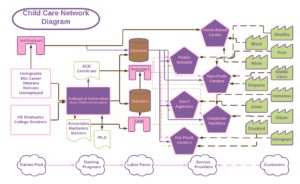“Number of child care workers declines in Georgia” – Courier Journal; “Staffing shortages wreak havoc on child care industry” – News 5 Cleveland; Iowa child care centers struggle to find staff” – KCRG. All over the country, the issue of adequate staffing continues to be a challenge for the child care industry. Unlike many news stories that fade away over time, the issue of child care will not fade away as long as it is seen as an obstacle for women to return to or participate in the labor force. A Bureau of Labor Statistics analysis shows that labor in the child care industry is down 15% from pre-pandemic levels that were already problematic. Furthermore, low wages have been identified and highlighted as a major industry concern.
The Universal Child Care and Early Learning Act– introduced by Senator Warren, and the Child Care for Working Families Act, introduced by Congressman Scott, both recommend increasing the wages of child care providers to equal that of K-12 school teachers. Given the similarities in duties, particularly at child care centers that provide Pre-K and are responsible for following the same guidelines as public schools, teachers in both systems should receive equal pay.
However, is it a good idea to equate their wages at the current pay levels for elementary school teachers? A report released by the Economic Policy Institute states that “After accounting for education, experience, and other factors known to affect earnings, teachers’ weekly wages in 2018 were 21.4 percent lower than their non-teaching peers.”

Figure 1, examines the child care network from a supply chain point of view.
In this diagram, we can see the labor force participants and the factors that work together to maintain an adequate supply of labor in the industry. The training pool, consisting of potential workers from various stages and walks of life, feeds into the training pipeline, currently administered completely through academic institutions. These institutions provide training and certification for entry-level members of the labor force.
Upon receiving either an early childhood education certificate or degree, new employees in the child care industry are now qualified and eligible to fill staff and teacher positions. There are several different types of centers, including home-based, public schools, non-profit centers, government agencies, corporate facilities, and for-profit organizations. All of these factors work together to provide child care services to the customers – the families.
If the supply of trained child care workers is sufficient to meet the demand, then policies aimed at increasing wages and benefits could convince the workers who have left the child care labor force to return, which would reduce the labor shortage. In contrast, if more child care workers need to be trained, creating partnerships with higher education institutions is needed.
The childcare shortage did not get here overnight, and we will not solve it overnight. However, what we can do is our due diligence in examining the right factors, creating the right policies, and supporting the right people – the families, the providers, and the WORKERS.
Kind regards,
Jerry


